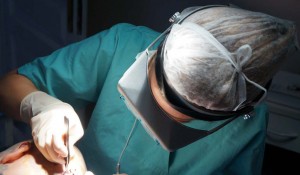A most frequent questions our surgeons are being asked is “Will my donor area grow back after FUE?”.
After we carefully check the donor measurements and take the time to calculate a reasonable harvest number, this question comes often as a surprise to us. Over time, we have come to realize that many rumors and pseudo-scientific claims are propagating throughout the internet, encouraging the myth of unlimited donor area. Some clinics even openly claiming a measured regrowth rate on the website. Therefore, it is no wonder that patient expect the impossible.
When it sounds like magic, looks like magic, promising magic: you can be sure there is a trick! In this case, the trick is called the “Playing on the transection rate”.
Donor area regrowth after FUE, an amazing fairy tale.
Wouldn’t it be great if ….
…If the hair follicule would regrow in the donor area after FUE harvest, we could just wait until for harvested hair to regrow in the receiver area and the donor area, and just harvest it again and again ( by the way, that’s what the Extracellular matrix ACell researches are all about).
…If the hair follicule would regrow in the donor area after FUE harvest, we could make infinite donor area and fill all the bald part, no matter it’s size.
…If the hair follicule would regrow in the donor area after FUE harvest, it would mean that hair surgery by FUE is a no-consequence surgery for the donor area. Take 1 hair from the donor and get 1 in the receiver area, and 1 in the donor area, therefore 2 for 1. it’s a “Buy 1 get 2” permanent sale with 0 impact on the donor area.
Hence, the question? Why are surgeons even bothering to check the donor area? why the measurements? why calculate the hair density and hair caliber ? And even why bother with the receiver area surface? If your follicular unit respawns after harvest, you have an unlimited donor area.
Wound’t it be great !
Frankly, we wish for it too…
But it’s simply not real.
Truthfully, those claims are very good marketing use of FUE’s potential risks.

Does hair multiplication by FUE exist?
Many researches have taken place on follicular multiplication by cutting the follicule. The principle is similar to plant cloning, we multiply the plant by cutting it and making the cut parts grow.
But the human body is complex, and results up till now have been mostly coming to the same conclusions: it is impossible to produce 2 healthy follicules each producing 1 healthy hair from the same starting follicule. According to where the cut is done on the follicule, it happens that both parts survive. But it those cases the hairs produced are not healthy and are similar to velus hair ( no color , no length, no caliber) ( Dr M Kulahci / Dr Ergin Er- ISHRS 2005).
Dr Ali Emre Karadeniz has posted very promising research on post transection regrowth( ISHRS 2015). Those research deserve to be more largely investigated and repeated as these research are opening new paths to follicular unit regrowth after transection, but these findings remain at a early stage and need deeper analysis.
Follicular transection, the number 1 risk with FUE
When the FUE punch ( the cylinder blade) comes into the skin to isolate the follicules, the follicules are still inside the skin. therefore the doctor isolating the grafts cannot see around the follicular unit and therefore can only “guess” where the edges of the follicular unit are actually situated. The aiming part is crucial to the good harvest. If the aiming is slightly off target ( and we are literally talking about aiming at hair diameter precision) the punch blade could cut into the follicules. That happens with every FUE operation; and because it’s specific, doctors have named it: it’s called transection.
The more twisted the follicule is, the more difficult it is to isolate the graft inside the skin, while getting a preserved transplantable follicular unit. If the follicular unit is damaged, and even more so on multi-hairs follicular units, there is a chance that the damaged follicule stays inside the donor area. There is a chance that this follicule might regrow. But if it does… it’s by mistake.
This is the regrowth that is used to claim for this “donor area regrowth”. It isn’t a spontaneous regrowth nor a a conscious act. It is an accident that is convenient for those claiming for regrowth in the donor area. It is a regrowth based on poor isolation of the follicular units inside the skin.
Most of the times when this regrowth actually happens, the quality of the hair collected, both in donor or receiver area, is poor. Less caliber, less colour, less strength.
Transection rate is normally used to evaluate the quality of the FUE harvest, the lower the transection the better the quality of the graft. Poor transection rate = poor FUE harvest.
Note: this article was written on may 26 2013, and reedited and completed on april 1st 2016
Auteur : P Hollenbeck
